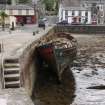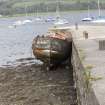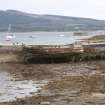Co-worker: Port Bannatyne Quay
Motor Fishing Vessel (20th Century)
Site Name Co-worker: Port Bannatyne Quay
Classification Motor Fishing Vessel (20th Century)
Alternative Name(s) Bf247
Canmore ID 300868
Site Number NS06NW 8006
NGR NS 07235 67313
Datum Datum not recorded
Permalink http://canmore.org.uk/site/300868
- Council Argyll And Bute
- Parish Maritime - Argyll And Bute
- Former Region Strathclyde
- Former District Maritime
- Former County Not Applicable
Field Visit (December 2003)
(Location cited as NS 03630 66237). Unknown: a wreck in poor condition survives within the intertidal zone (on a beach). It is apparently of wooden construction and of 18th-20 century AD date. [No further information].
MS/2256 (p. 89, no. 151 'Ettrick Bay').
Note (21 October 2009)
The location assigned to this record remains unverified.
This wreck is not visible on OS vertical air photograph 12/88/212.
Information from RCAHMS (GG), 22 October 2009.
Note (22 October 2009)
The cited location falls on the sandy beach on the NE side of Ettrick Bay, about 500m NW of the mouth of the Colmac Burn.
The loss of this vessel is not cited by I G Whittaker (1998).
Information from RCAHMS (RJCM), 22 October 2009.
Note (21 April 2011)
The wreck of the Banff registered fishing vessel the 'Co-worker', first noted during a coastal survey in 2003, was removed from Ettrick Bay to Port Bannatyne where it now lies against the quay (NS06NE 47).
Information from RCAHMS (GG), 21 April 2011.
Desk Based Assessment (28 November 2014)
No further information found on shipbuilder or build-place of the Co-worker .The name does not appear on www.clydesite.co.uk [accessed 28 November 2014] suggesting the Co-worker may not be Clyde-built.
Information from Sally Evans (Cotswold Archaeology), 28/11/2014.
Project (October 2014 - April 2015)
The maritime archaeology of the Clyde has been identified as a focus for a major study of human interaction with the river through time by the RCAHMS following on from recommendations by the Scottish Archaeological Research Framework (ScARF). Source to
Sea has been developed as the long-term research programme, of which the research into human connections with the River Clyde forms part. This project has comprised a study of the surviving shipwreck heritage of Clyde-built vessels lost within the Clyde estuary and Firth of Clyde.
This project has collated information from a range of sources and has enhanced knowledge of Clyde-built wrecks within the Clyde. In particular information from recreational divers has proved invaluable and has been the source of detailed information about the current condition of many Clyde-built wrecks, useful for on-going management. A number of wrecks previously recorded as of unknown identity in the RCAHMS database were positively identified during the project and more accurate positional information was established for a number of other wrecks. Additionally, the project identified a potentially significant wreck (Margaret Niven) the remains of which were not previously recorded. This project has also identified a number of other potentially significant wrecks within the Clyde, which reflect both its unique contributions to world-wide shipbuilding and local connections. These wrecks include paddle steamers (Lapwing and Princess of Wales), Clyde Puffers (e.g. Margaret Niven), steam-yachts with military connections (HMS Breda), a dredger (Greenock) and an 18th-century West Indiaman (Lady Margaret). Numerous other wrecks have been identified by this project, and all display some degree of significance.
Information from Sally Evans (Cotswold Archaeology) April 2015












